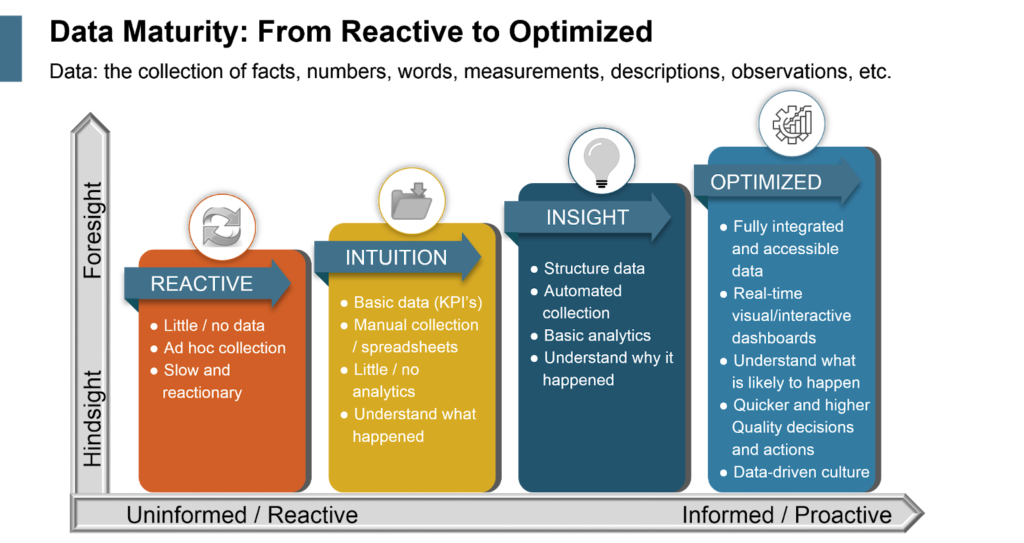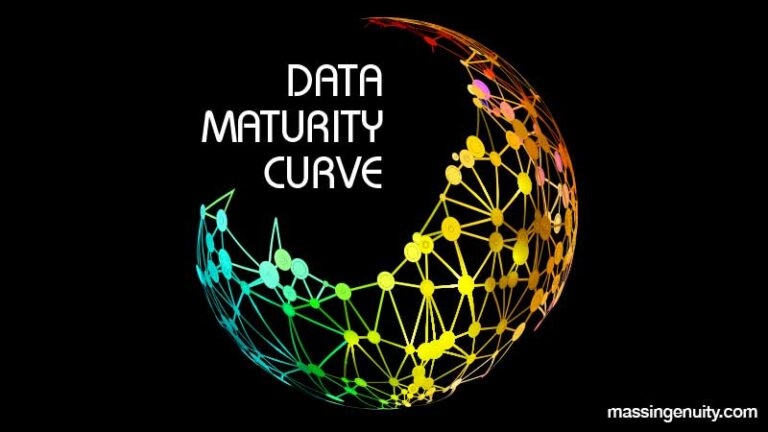The data maturity curve, otherwise referred to as the data maturity modeling, is a business tool measure that can determine just how advanced your data culture is.
An optimal data maturity level is the state where data has been intricately woven into the fabric of your company’s day-to-day functions. At this stage, data is deeply integrated into all business decision-making processes.
What Is The Significance Of Data Maturity For A Business Organization?

Generally speaking, data maturity is intrinsically correlated with a company’s overall enterprise performance management.
Data has been comprehensively proven to be an essential competitive differentiator among business organizations.
Today, highly successful companies have come to recognize they will require a substantial amount of data and effective analytics, through enterprise performance management software, to make better decisions and gain a competitive edge over their competition. The more resourceful businesses out there are also combining existing and newer data sets in totally novel ways. At the same time, they are applying advanced analytics capabilities to pinpoint hard-to-find correlations along with connections in order to make better and quicker decisions.

With the great advances made in enterprise performance management strategies, and in particular big data, technology like Results Software is now fully capable of leveraging all kinds of business data. However, for companies to be in a position of extracting meaningful value from their data, they need to create operational data models, which can address specific business challenges.
They, as well, need to invest wisely in suitable data visualization tools, such as Results Software, and employ them in all stages of their data’s life cycle. To be able to meet both these prerequisites, a business must first figure out just where it is positioned on the data maturity curve. Here then are the four different stages of the data maturity curve.
Reactive Stage

Businesses that are in the reactive stage of the data maturity modeling tend to generate little or sometimes no intelligence from their data at all in their day-to-day core operations.
Also, if they do indeed collect any data, it is often on an ad-hoc basis, without proper data visualization applications involved. This means the various decisions they make are not only slow, but reactionary too. In this phase, businesses may have in place multiple data sources, but there is usually no data and applications integration.
Lastly, such companies tend to employ an ad-hoc reporting capability, and don’t trust their own reports. Should this be the stage where your business lies on the data maturity curve, there are a number of capabilities you will need to develop to move up the ladder. This includes focusing more on proper data definition and modeling, data normalization, feeding data into a reporting system, and creating a reporting dashboard for your team.
Intuition Stage
At the intuition stage, a company will have begun to question the quality of the data it generates.

Additionally, such businesses might have multiple databases or even incomplete data warehouses. Nevertheless, there will still be no application integration. At this phase of the data maturity modeling, organizations may have started tracking organizational KPIs, but lack the know-how to be able to manipulate or utilize unstructured data through data visualization tools.
If this sounds like your company, you should start to concentrate on developing proficiency in assessing data quality and understanding how it drives your decisions. While also making an effort to implement new technology like Results Software to deal with unstructured data, optimize your data warehouse (if applicable), and implement a master data management strategy.
Taking these actions will furnish your business with the capability of achieving standardized reporting with an organization-wide enterprise performance management platform.
Insight Stage

A company positioned at the insight stage of the data maturity curve will have already started leveraging data in its decision-making process.
Also, businesses at this phase will have put in place executive sponsorship to be able to break down organizational silos together with data silos. Companies at the insight stage will, as well, have started using data as a competitive differentiator.
Should you be at this phase, it is important to implement technology that will integrate all your business’s data sources and applications. Doing this will help you provision and store your data more efficiently and serve it up to end-users on demand.
Optimized Stage
The optimized stage is the final step to full data maturity. As such, a company positioned at this phase is completely data-driven in all its decision-making processes. In effect, a true data culture has been established.
Additionally, such a business will have completely integrated most of its data sources and applications. More importantly, they will have implemented an advanced analytics platform like Results Software, and already figured out where and how to embed analytics into all its core functions. A business at this stage of the data maturity curve will have invested in need-oriented applications for different roles including marketing, sales, HR, operations, and so on. They will also be using prescriptive analytics to create better responses and actions, built machine learning, forecasting modeling, and finally, developed sentiment analytics capabilities.
Determining just where your business is positioned on the data maturity curve can be an indicator of your next action steps. First, you’ll be able to figure out the improvements that are needed to quickly climb up the ladder, including investing more in the right technology. You will also be able to be in a good position of integrating data from multiple sources, and extracting useful insights on how to use it as a competitive differentiator to always stay a step ahead of rival businesses. Lastly, you’ll ultimately achieve the desired goal of landing an optimized stage of the data maturity modeling, and establish a data-driven culture in all your decision-making processes.
Scott Harra,
Executive Vice President of Marketing and Government Relations

